Beginner's Guide to Selling on Amazon
Amazon, with its millions of customers, plays a significant role in e-commerce shopping. A study says 90% of UK customers use Amazon to shop for products online. Amazon has become a go-to destination for businesses and individual sellers looking to expand their reach.
If you’re new to this, figuring out the Amazon seller account setup and the nuances of the Amazon marketplace can seem daunting. However, with the right approach and understanding of Amazon's sales strategy, selling on Amazon can be highly rewarding.
Contents
Why Do People Choose Amazon to Purchase Their Products?
How to Sell on Amazon?
Key Strategies for Successful Selling on Amazon
Conclusion
Why Do People Choose Amazon to Purchase Their Products?
Before selling on Amazon, let’s understand why people use Amazon to purchase products:
Over half of Amazon customers believe Amazon gives the lowest prices.
Nearly 28% of the customers use Amazon due to its competitive pricing.
The majority of shoppers prioritize free shipping over quick delivery.
About 19% of the users subscribe to Amazon Prime to enjoy free shipping.
How to Sell on Amazon?
Before selling a product on Amazon, decide on what type of products you want to sell, keeping in mind Amazon's product restrictions and seller fees. Next, set up your seller account and put together your product listings. After that, keeping track of your inventory and handling order fulfillment is essential. Lastly, since Amazon is a highly competitive space, monitoring and managing your store's performance is crucial.
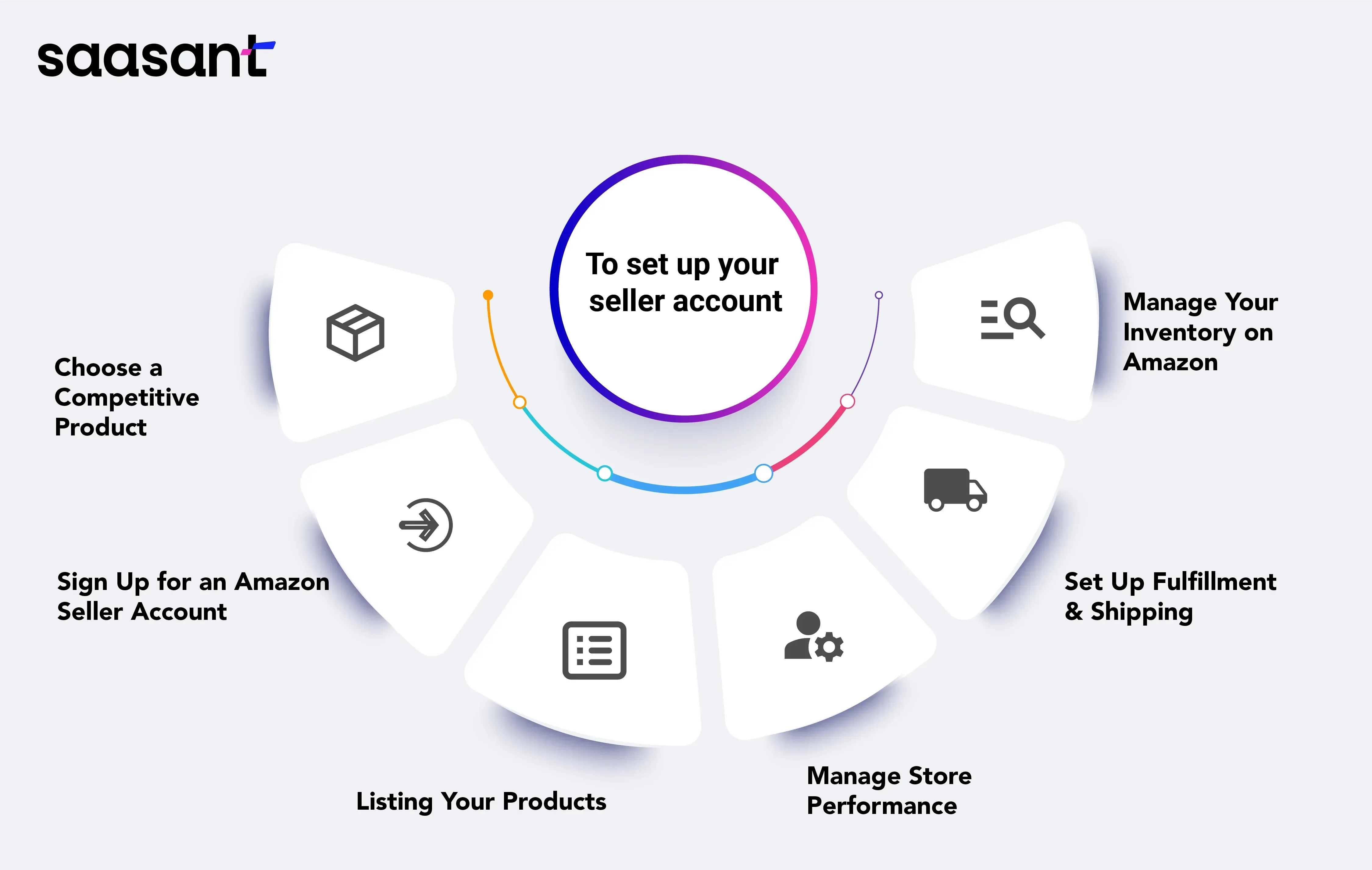
Let’s look into this in detail.
Step 1: Choose a Competitive Product
You must understand Amazon's restrictions and seller fees to develop a sales strategy and decide the best products to sell. This step is crucial in researching and selecting products that have the potential to be successful.
While some products might be popular and profitable, their related fees and rules could lead to extra work or expenses.
All products on Amazon must adhere to specific policies. If you need clarification on the regulations for a product, it's wise to consult a legal expert.
There are additional rules for:
Category Approval: Some categories, like jewelry, music, and watches, require Amazon's approval before listing. Knowing this beforehand can save time and effort.
Fulfillment by Amazon (FBA) Restrictions: If opting for FBA, knowing its specific restrictions is crucial to ensure smooth operations.
State-Specific Regulations: For example, products sold in California may have additional rules.
FDA-Related Claims: Take special care with products making FDA-related claims to avoid misleading customers and potential legal issues.
Step 2: Sign Up for an Amazon Seller Account
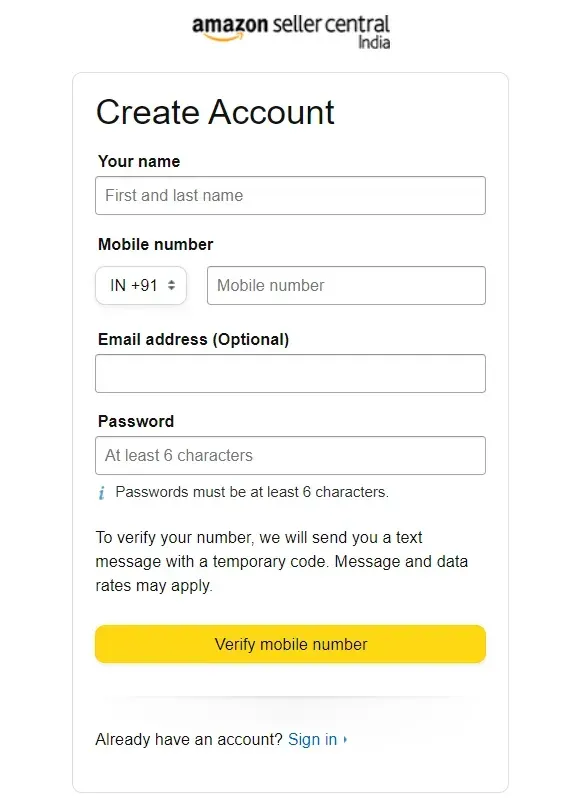
Before you start selling on Amazon, you must set up a seller account. Seller Central is the online portal where sellers can track their sales activity on Amazon. In addition, you can handle inventory management, adjust prices, communicate with customers, contact seller support, and introduce new products.
Signing up for a seller account begins with choosing between two types of seller plans: Individual and Professional. The Professional plan offers more features and costs $39.99 per month, while the Individual plan is free but charges 99 cents for each item sold. Both plans have additional fees for each product listed.
When you register, you can use your existing Amazon customer account or create a new seller account with your business email.
Make sure to have the following information available for the sign-up:
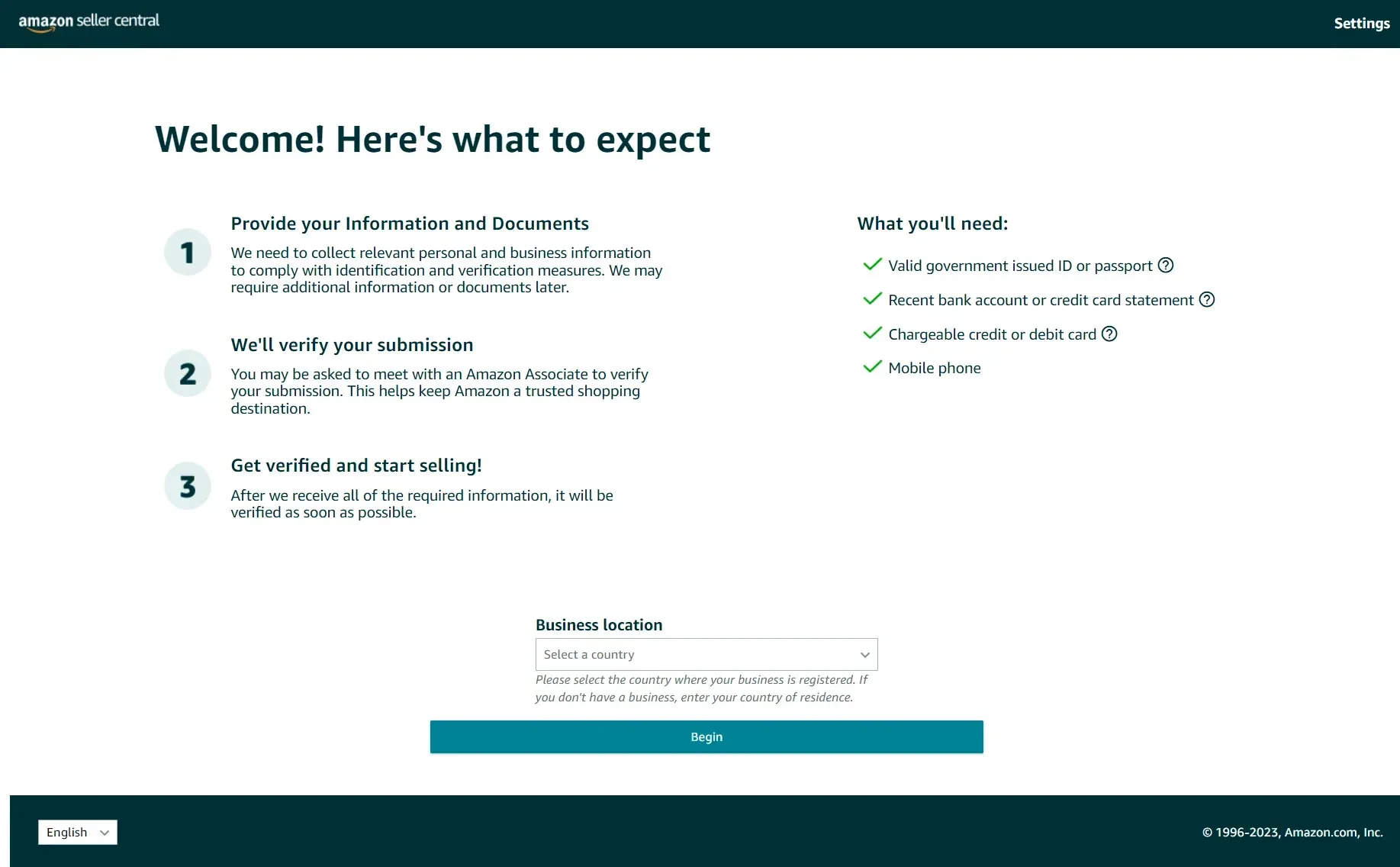
Your bank account number and routing number
A chargeable credit card
A government-issued ID
Your tax information
A contact phone number
Visit Seller Central to start registration and follow the instructions to create a seller account.
After completing these steps, you will gain access to the Seller Central Dashboard, where you can begin listing your products for sale on Amazon.
Step 3: Listing Your Products
Create product listings that are clear, informative, and appealing. Include essential product details such as features, specifications, and unique selling points.
Upload high-quality images and detailed descriptions as they play a pivotal role in attracting customers. Shoot your pictures professionally, and ensure your descriptions accurately reflect the product.
Competitive pricing is vital. Use Amazon’s pricing tools and conduct market research to set prices that are attractive to customers yet profitable for your business.
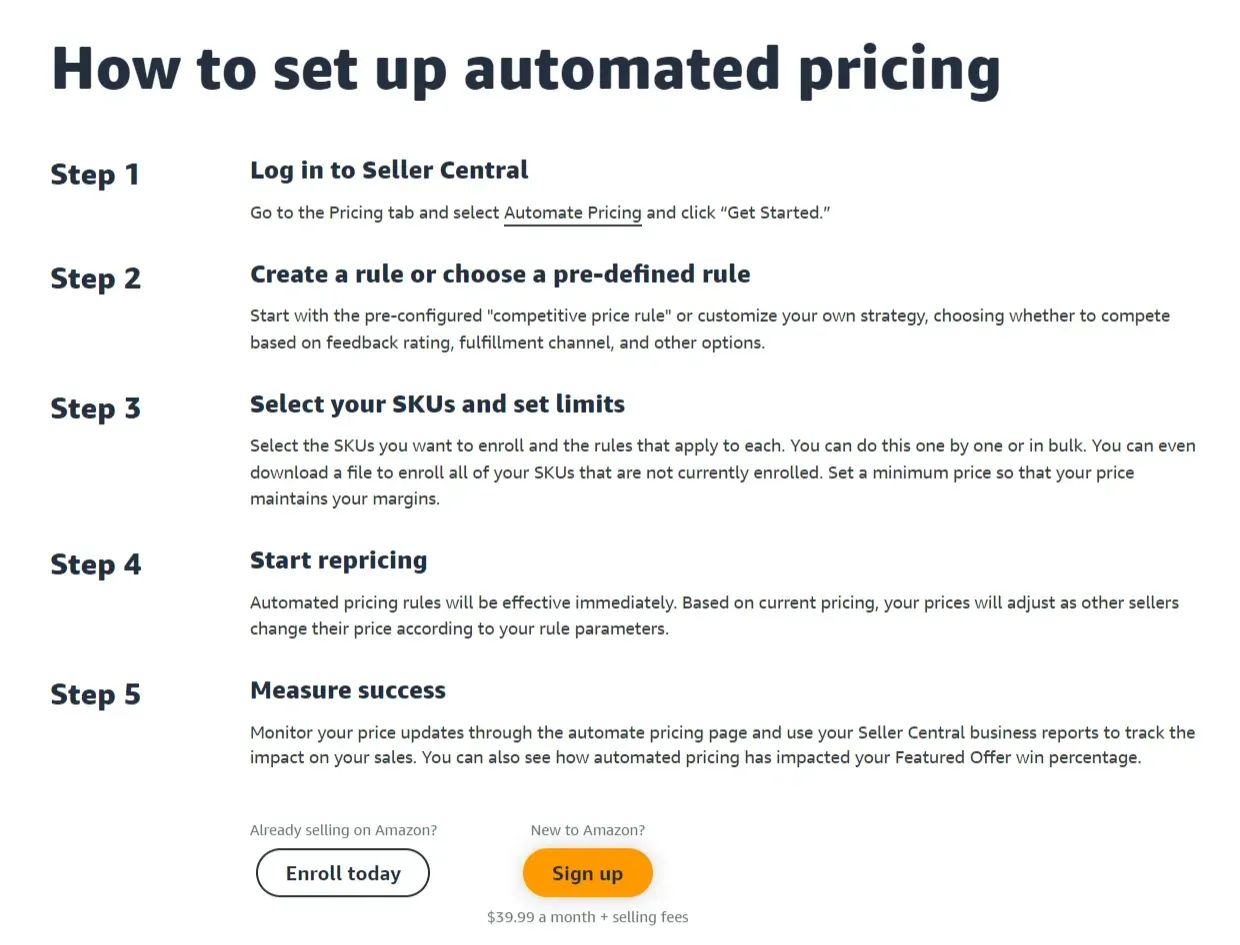
Step 4: Manage Your Inventory on Amazon
Amazon’s Seller Central offers an inventory management dashboard to help sellers monitor inventory levels, sales, deliverables, and orders across international marketplaces.
The dashboard sends alerts when there is a low stock and helps you manage products and shipping schedules. The dashboard shows crucial data such as sell-through rates, aging stock alerts, and storage optimization recommendations.
With the help of Amazon's Inventory Management, you can get automated inventory updates and monitor products within warehouses. Additionally, Amazon's dashboard takes care of inventory tracking and updates, so sellers need not worry about their inventory management.
Step 5: Set Up Fulfillment & Shipping
As a seller on Amazon, you have two choices for product delivery. Firstly, you can handle it independently, which involves managing your inventory and shipping items directly to customers, known as merchant fulfillment. Alternatively, you can opt for Amazon's Fulfillment by Amazon (FBA) service, where Amazon takes care of packaging, labeling, and shipping.
Ship Amazon Orders Yourself (FBM)
Many beginners initially handle Amazon order shipments themselves. Numerous established e-commerce sellers also fulfill all their Amazon orders from their warehouses. This method is what Amazon FBM is, also known as FBM by Amazon.
If you opt for this approach but are new to the shipping process, Amazon simplifies it, especially for small-scale operations. You can print orders and shipping labels from your Seller Central dashboard for the US Postal Service. Be sure to have your shipping materials prepared, including:
Shipping boxes
Packing tape
Filler material like paper or bubble wrap
A shipping scale
Convenient access to shipping services for dropping off packages or a secure location for pickups
Ship Your Products Through Amazon
With Amazon's Fulfillment by Amazon (FBA) service, you send your products to Amazon; they will take care of storage, packaging, and shipping. When a customer orders your product, Amazon handles the payment collection and transfers your earnings every two weeks.
Opting for FBA does mean incurring additional fees on top of your regular Amazon seller fees. However, it offers several significant benefits that boost sales, such as:
Prime Eligibility: Most listed items FBA handles are Amazon Prime products.
Free Shipping for Prime Members: Your products become eligible for free 2-day shipping for Prime members.
Improved Product Listing Rankings: Amazon favors FBA sellers in its product listing rankings.
Increased Chances in the Buy Box: FBA sellers are likelier to win the Buy Box when prices are competitive.
Enhanced Trust: Customers generally have more confidence in the timely and reliable delivery of items fulfilled by Amazon.
Post-Sale Services: FBA manages all customer interactions related to your orders, including inquiries, returns, and refunds. Amazon's customer service team is available 24/7 via phone, email, or live chat.
Comparing Amazon FBA and Amazon FBM
Feature | Amazon FBA (Fulfillment by Amazon) | Amazon FBM (Fulfillment by Merchant) |
Fulfillment | Handled by Amazon. Products are stored in Amazon's warehouses, and Amazon manages packaging, shipping, and returns. | Handled by the seller. The seller is responsible for storing inventory, packaging, shipping, and handling returns. |
Shipping Speed | Often eligible for Prime shipping, which means faster delivery times for customers. | It depends on the merchants. Can be slower compared to FBA unless the merchant has a robust logistics setup. |
Costs | Fees include storage fees, fulfillment fees, and additional long-term storage fees. | Costs include personal storage, shipping, and packaging expenses but no Amazon fulfillment fees. |
Customer Service | Handled by Amazon, including returns and exchanges. | Managed by the seller, which can be more demanding but allows for personalized customer service. |
Scalability | More scalable for larger volumes due to Amazon's extensive network and resources. | Only be scalable if the seller has significant resources and systems for handling increased volume. |
Step 6: Manage Store Performance
After launching your store, it's essential to keep track of your sales and evaluate and enhance your store's performance for its sustained success. Using an application like PayTraQer can be highly beneficial in this process. PayTraQer allows you to sync Amazon sales with QuickBooks or Xero automatically and makes your sales tracking easier.
Key Performance Metrics
Amazon prioritizes customer satisfaction and expects its sellers to provide an excellent customer experience consistently. Be aware of the following key performance metrics that Amazon enforces:
Order Defect Rate (reflecting customer service quality): Must be less than 1%.
Pre-Fulfillment Cancel Rate (cancellations made by the seller before shipping): Should be under 2.5%.
Late Shipment Rate (orders shipped after the expected date): Should be below 4%.
Failing to meet these benchmarks could lead to negative performance evaluations and impact your product listings' visibility on Amazon.
Learn to Advertise
Amazon also provides various advertising options for sellers to connect with and attract shoppers.
Sponsored Products: Ads for individual listings on Amazon that boost product visibility and sales, appearing on search results and product detail pages.
Sponsored Brands: Ads appearing in search results featuring your brand logo, a custom headline, and up to three products, helping to highlight your brand and products.
Amazon Stores: Customizable multi-page stores that allow sellers to showcase their brand story and products.
Offer Promotions
Promotions are a great way to encourage immediate purchases. On Amazon, you can offer discounts such as money off, free shipping, or buy one get one free deals.
Key Strategies for Successful Selling on Amazon
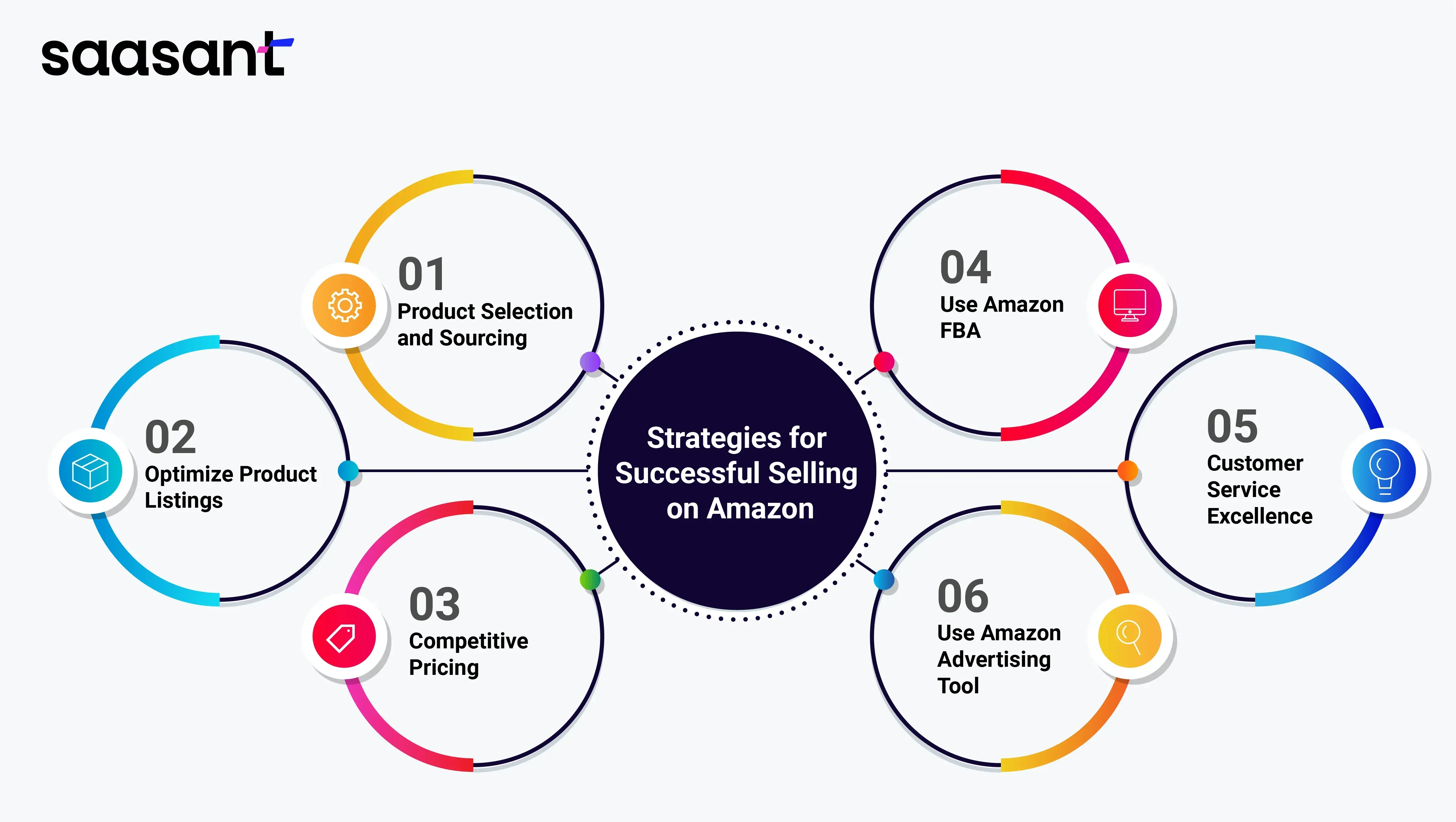
Product Selection and Sourcing: Choose products with high demand and low competition.
Optimize Product Listings: Use high-quality images and detailed descriptions. Incorporate relevant keywords for better search visibility.
Competitive Pricing: Set prices that are competitive yet profitable. Monitor competitors' pricing and adjust accordingly.
Leverage Amazon FBA: Use Fulfillment by Amazon (FBA) for efficient shipping and handling, which can also improve product visibility and customer trust.
Customer Service Excellence: Provide prompt, helpful customer service. Address issues and feedback swiftly to maintain high seller ratings.
Gather and Use Customer Reviews: Encourage customers to leave reviews and use their feedback to improve products and services.
Use Amazon Advertising Tools: Invest in Amazon's advertising options like Sponsored Products to increase visibility.
Inventory Management: Keep track of your inventory levels to avoid stockouts or overstocking.
Regular Analysis and Adaptation: Regularly analyze your sales data and market trends to adapt your strategies.
Compliance with Amazon Policies: Stay updated with Amazon's policies and guidelines to avoid any account issues.
Conclusion
Whether you're a newcomer to Amazon or have been managing your store for some time, Amazon provides vast potential for expansion and success. By engaging in detailed product research, choosing the appropriate seller account, understanding Amazon's regulations, and refining your product listings, you can establish a strong base for your business on Amazon.
If you want to know more about Amazon selling without inventory, read how to sell on Amazon without inventory.